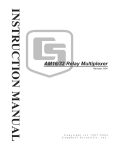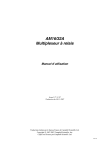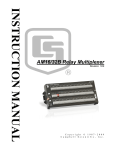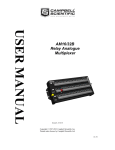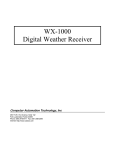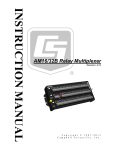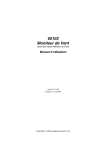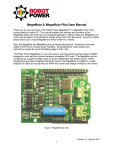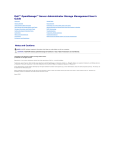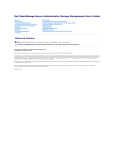Download Campbell AM416 Instruction manual
Transcript
AM416 RELAY MULTIPLEXER INSTRUCTION MANUAL REVISION: 2/96 COPYRIGHT (c) 1987-1996 CAMPBELL SCIENTIFIC, INC. WARRANTY AND ASSISTANCE The AM416 RELAY MULTIPLEXER is warranted by CAMPBELL SCIENTIFIC, INC. to be free from defects in materials and workmanship under normal use and service for twelve (12) months from date of shipment unless specified otherwise. Batteries have no warranty. CAMPBELL SCIENTIFIC, INC.'s obligation under this warranty is limited to repairing or replacing (at CAMPBELL SCIENTIFIC, INC.'s option) defective products. The customer shall assume all costs of removing, reinstalling, and shipping defective products to CAMPBELL SCIENTIFIC, INC. CAMPBELL SCIENTIFIC, INC. will return such products by surface carrier prepaid. This warranty shall not apply to any CAMPBELL SCIENTIFIC, INC. products which have been subjected to modification, misuse, neglect, accidents of nature, or shipping damage. This warranty is in lieu of all other warranties, expressed or implied, including warranties of merchantability or fitness for a particular purpose. CAMPBELL SCIENTIFIC, INC. is not liable for special, indirect, incidental, or consequential damages. Products may not be returned without prior authorization. To obtain a Returned Materials Authorization (RMA), contact CAMPBELL SCIENTIFIC, INC., phone (435) 753-2342. After an applications engineer determines the nature of the problem, an RMA number will be issued. Please write this number clearly on the outside of the shipping container. CAMPBELL SCIENTIFIC's shipping address is: CAMPBELL SCIENTIFIC, INC. RMA#_____ 815 West 1800 North Logan, Utah 84321-1784 CAMPBELL SCIENTIFIC, INC. does not accept collect calls. Non-warranty products returned for repair should be accompanied by a purchase order to cover the repair. 815 W. 1800 N. Logan, UT 84321-1784 USA Phone (435) 753-2342 FAX (435) 750-9540 www.campbellsci.com Campbell Scientific Canada Corp. 11564 -149th Street Edmonton, Alberta T5M 1W7 CANADA Phone (403) 454-2505 FAX (403) 454-2655 Campbell Scientific Ltd. Campbell Park 80 Hathern Road Shepshed, Leics. LE12 9RP ENGLAND Phone (44)-50960-1141 FAX (44)-50960-1091 AM416 RELAY MULTIPLEXER MANUAL TABLE OF CONTENTS PAGE 1. 1.1 1.2 FUNCTION Typical Applications ................................................................................................................... 1 Compatibility .............................................................................................................................. 1 2. PHYSICAL DESCRIPTION .................................................................................................... 1 3. AM416 SPECIFICATIONS...................................................................................................... 3 4. OPERATION ............................................................................................................................... 3 4.1 4.2 5. 5.1 5.2 5.3 6. 6.1 6.2 6.3 6.4 6.5 6.6 6.7 The Control Terminals............................................................................................................... 3 The Measurement Terminals .................................................................................................... 6 DATALOGGER PROGRAMMING Single Loop Instruction Sequence............................................................................................. 6 Multiple Loop Instruction Sequence .......................................................................................... 9 General Programming Considerations .................................................................................... 10 SENSOR HOOK-UP AND MEASUREMENT EXAMPLES Single-Ended Analog Measurement without Sensor Excitation .............................................. 10 Differential Analog Measurement without Sensor Excitation................................................... 11 Half Bridge Measurements...................................................................................................... 11 Full Bridge Measurements....................................................................................................... 13 Full Bridges with Excitation Compensation ............................................................................. 13 Thermocouple Measurement .................................................................................................. 14 Mixed Sensor Types................................................................................................................ 16 7. GENERAL MEASUREMENT CONSIDERATIONS ...................................................... 18 8. INSTALLATION 8.1 Environmental Constraints................................................................................................................ 18 APPENDIX A. AM416 STUFFING CHART AND SCHEMATICS.....................................A-1 APPENDIX B. DIFFERENCES BETWEEN THE AM416 AND AM32 ............................B-2 LIST OF FIGURES 1. 2. 3. 4. 5. 6. 7. 8. 9. 10. Plan View of the AM416 Relay Multiplexer................................................................................ 2 Hook-up Diagrams for Datalogger - AM416 Connections ......................................................... 4 Power and Ground Connections for External Power Supply..................................................... 5 Actuation Time of Relays vs. Temperature (o) and Battery Voltage.......................................... 6 Single Loop Instruction Sequence............................................................................................. 6 Example Program Loops for CR10(X), 21X, and CR7 Dataloggers ......................................... 8 Wiring Diagram for Strain Gages and Potentiometers .............................................................. 9 Single-ended Measurement without Excitation ....................................................................... 11 Differential Measurement without Excitation ........................................................................... 11 Half Bridge (Modified 107 Temperature Probe) Hook-up and Measurement.......................... 12 i 11. 12. 13. 14. 15. 16. 17. Potentiometer Hook-up and Measurement ............................................................................. 12 Four Wire Half Bridge Hook-up and Measurement ................................................................. 13 Differential Measurement with Sensor Excitation .................................................................... 13 Full Bridge Measurement with Excitation Compensation ........................................................ 14 Differential Thermocouple Measurement with Reference Junction at the Datalogger ............ 15 Differential Thermocouple Measurement with Reference Junction at the AM416 .................. 15 Thermocouple and Soil Block Measurement........................................................................... 16 ii CAUTIONARY NOTES The AM416 is not designed to multiplex power. Its intended function is to switch low level analog signals. Switched current in excess of 30 mA will degrade contacts and render them unsuitable for future low level analog measurements. Customers who need to switch power are directed to CSI's A6REL-12 or A21REL-12 relays. Adjacent AM416 channels may be shorted together for up to 5 ms during the clocking procedure. Users should consider this when assigning AM416 input channels. Sensors that are capable of sourcing current should not be assigned input terminals adjacent to sensors that can sink current. AM416 RELAY MULTIPLEXER 1. FUNCTION The primary function of the AM416 Multiplexer is to increase the number of sensors that may be scanned by Campbell's CR10(X), 21X and CR7 dataloggers. The AM416 is positioned between the sensors and the datalogger; mechanical relays are used to switch the desired sensor signal(s) through the system. Most commonly, users will multiplex signals from analog sensors into single-ended or differential datalogger channels. Four lines are switched simultaneously; a maximum of sixteen sets of (four) lines may be scanned, hence the name A(nalog) M(ultiplexer) 4(lines x) 16(sets). Therefore, a total of 64 lines may be multiplexed. The maximum number of sensors that can be multiplexed through one AM416 depends primarily upon the type(s) of sensors to be scanned. Some examples (assuming identical sensors) follow: 1. Up to 32 single-ended or differential sensors that do not require excitation (e.g. pyranometers, thermocouples; Sections 6.1, 6.2, and 6.6). 2. Up to 48 single-ended sensors that require excitation (e.g. some half bridges; Section 6.3.1). 3. Up to 16 single-ended or differential sensors that require excitation (e.g. full bridges, four-wire half bridge with measured excitation; Section 6.3.3 and 6.4). 4. In conjunction with an AM32 multiplexer, up to 16 six-wire full bridges (Section 6.5). 1.1. TYPICAL APPLICATIONS The AM416 is intended for use in applications where the number of required sensors exceeds the number of datalogger input channels. Most commonly, the AM416 is used to multiplex analog sensor signals, although it also may be used to multiplex switched excitations, continuous analog outputs, or even certain pulse counting measurements (i.e. those that require only intermittent sampling). It is also possible to multiplex sensors of different, but compatible, types (e.g. thermocouples and soil moisture blocks, see Section 6.6). NOTE: For a discussion of single-ended versus differential analog measurements, please consult the Measurement Section of your datalogger manual. As purchased, the AM416 is intended for use in indoor, non-condensing environments. An enclosure is required for field use. In nonthermocouple applications where a single multiplexer is deployed, the AM-ENC enclosure is recommended. In thermocouple applications, CSI recommends use of the AM-ENCT enclosure. If several multiplexers are deployed at the same site in a non-thermocouple application, the 024 or 030 enclosures provide cost-effective housing options. 1.2 COMPATIBILITY The AM416 is compatible with Campbell's CR10(X), 21X or CR7 dataloggers. The AM416 is compatible with a wide variety of commercially available sensors. As long as current limitations are not exceeded, and no more than four lines are switched at a time, system compatibility for a specific sensor is determined by sensor-datalogger compatibility. In CR10(X) applications, the AM416 may be used to multiplex up to 16 Geokon vibrating wire sensors through one AVW-1 vibrating wire interface. 2. PHYSICAL DESCRIPTION The AM416 is housed in a 21 cm x 16.5 cm x 3.5 cm (8.2" x 6.5" x 1.5") anodized aluminum case (Figure 1). The aluminum case is intended to reduce temperature gradients across the AM416's terminal strips. This is extremely important when thermocouples are being multiplexed (Section 6.6). The case may be opened by removing the four #1 phillipshead screws located at the corners of the case. Disassembly of the case may be required to mount the AM416 to a plate or an enclosure (Section 8). A strain-relief flange is located along the lower edge of the top panel of the case. Several plastic wire ties are included with the AM416 to attach wires to this flange. 1 AM416 RELAY MULTIPLEXER Wires from sensors and datalogger are connected to the gray terminal strips. The set of four terminals located near the strain-relief flange are the connections for datalogger control of the AM416 (Section 4.1). The terminal strips that run the length of the AM416 are for measurement connections (Section 4.2). The sensor inputs are not spark gapped. All terminals accept stripped and tinned lead wires up to 1.5 mm in diameter. The datalogger is connected to the AM416 through a minimum of seven, but generally nine, individually insulated lead wires. AM416 RELAY MULTIPLEXER L2 H2 16 L1 H1 L2 H2 12 L1 H1 SHIELD SHIELD 14 L2 H2 L1 H1 SHIELD L2 H2 11 L1 H1 L2 SHIELD H2 L1 H1 7 SHIELD L2 H2 L1 H1 6 L2 H2 2 L1 H1 SHIELD SHIELD L2 L2 H2 L1 H1 H2 L1 H1 5 MADE IN USA FIGURE 1. Plan View of the AM416 Relay Multiplexer 2 3 L2 12V CLK GND SHIELD L2 H2 L1 H1 H1 9 RES 13 4 SHIELD L2 H2 10 L1 H1 SHIELD 8 L2 H2 L1 H1 L1 H2 L2 L2 H2 L1 H1 COM COM L2 H2 15 L1 H1 L2 H2 L1 H1 H2 1 L1 H1 AM416 RELAY MULTIPLEXER 3. AM416 SPECIFICATIONS POWER*: unregulated 12 VDC (9.6 V to 16 V) - See Figure 4 for implications of low power to relay actuation CURRENT DRAIN: Quiescent: < 100 uA Active: 17 mA (typical) RESET*: a continuous signal of 3.5VDC < voltage < 16 VDC holds AM416 in an active state (i.e. a clock pulse can trigger a scan advance). A signal voltage of < 0.9VDC deactivates the AM416 (clock pulse will not trigger a scan advance; AM416 is also reset). CLOCK*: on the transition from <1.5 V to >3.5 V, scan advance is actuated on the leading edge of the clock signal; clock signal must be a minimum of 5 ms in width. OPERATIONAL TEMPERATURE: -40oC to +65oC OPERATIONAL HUMIDITY: 0 - 95%, noncondensing DIMENSIONS (without field enclosure): length - 21 cm (8.2") width - 16.5 cm (6.5") depth - 3.5 cm (1.5") (with field enclosure i.e. box size): length - 25.4 cm (10.0") width - 20.3 cm (8.0") depth - 10.2 cm (4.0") WEIGHT: 1.5 lbs (approx.) (in enclosure): 10.0 lbs (approx.) EXPANDABILITY**(nominal): 3 AM416'S/CR10(X) 4 AM416'S/21X 8 AM416's/CR7 725 Card MAXIMUM CABLE LENGTH: sensor & scan rate dependent (in general, longer lead lengths necessitate longer measurement delays. Refer to datalogger manual for additional details). MAXIMUM SWITCHING CURRENT***: 500 mA * Reset, Clock, and +12V inputs are limited to +16V by 1.5KE20A transzorbs. ** Assumes sequential activation of multiplexers and that each datalogger channel is uniquely dedicated. If your application requires additional multiplexing capability, please consult CSI for application assistance. *** Switching currents greater than 30 mA (occasional 50 mA is acceptable) will degrade the contact surfaces of the mechanical relays (i.e. increase their resistance). This process will adversely affect the suitability of these relays to multiplex low voltage signals. Although a relay used in this manner will not be of use in future low voltage measurements, it may continue to be used for switching current in excess of 30 mA. CONTACT SPECIFICATIONS Initial contact resistance: 50 mohm max. Initial contact bounce: 1 ms max. Contact material: Gold clad silver alloy Electrostatic capacitance: 3pF Minimum expected life: Mechanical (at 50cps): 108 open Electrical (at 20cps): 2 x 105 CHARACTERISTICS (at 25oC, 50% Relative Humidity) Operate time 8 to 15 ms approx. (See Figure 4) Release time 5 ms approx. 4. OPERATION Subsection 4.1 discusses the use of the terminals that control operation of the multiplexer. These terminals are located along the lower left side of the multiplexer as shown in Figure 1. Subsection 4.2 discusses the use of terminals used in sensor measurement. 4.1. THE CONTROL TERMINALS The CR10(X), 21X and CR7 dataloggers should be connected to the AM416 as shown in Figure 2. This figure depicts control connections; measurement connections are discussed in Section 6. The power, ground, reset, and clock connections remain essentially the same regardless of datalogger used. In a CR10(X) application, the datalogger 12VDC supply and ground terminals are connected to the AM416 12V and ground terminals. Two control ports are used for clock and reset. 3 AM416 RELAY MULTIPLEXER FIGURE 2. Hook-up Diagrams for Datalogger - AM416 Connections CR10(X) Hook-up 21X Hook-up CR7 Hook-up The 21X or CR7 (with a 725 Card) can be used to connect 12VDC supply and ground to the AM416. One control port is used for reset, and one switched excitation channel is used for clock. If switched excitations are unavailable, a control port may be used to provide clock pulses to the multiplexer. 4.1.1 RESET Reset (RES) controls activation of the multiplexer. A voltage (3.5VDC <voltage< 16VDC) applied to this terminal activates the multiplexer. When this line is dropped to <0.9VDC, the multiplexer enters a quiescent, low current drain state. Reset is always connected to a datalogger control port. Instruction 86 (option code 41 - 48 [activate] and 51 - 58 [deactivate]) is generally used. With a 21X or CR7 with older PROMS, Instruction 20 is commonly used to activate and deactivate the multiplexer (set port high to 4 activate the multiplexer or low to enter quiescent mode). 4.1.2 CLOCK The multiplexer clock line (CLK) controls the switching between sequential sets of relays. When reset is set high and the multiplexer is activated, the multiplexer's common lines (COM H1, COM L1 COM H2, COM L2) are not connected to any of the sensor input terminals. When the first clock pulse is received, the common lines are switched into connection with multiplexer channel 1 (H1,L1,H2,L2). When a second clock pulse is received, the common lines are connected to multiplexer channel 2 (H1,L1,H2,L2). Adjacent Multiplexer input channels are momentarily shorted to each other during the switch (e.g. channel 1 H1 to channel 2 H1, channel 1 L1 to channel 2 L1, etc. See Cautionary Notes). The multiplexer is clocked on the leading edge of the voltage pulse. The AM416 RELAY MULTIPLEXER voltage level must fall below 1.5VDC then exceed 3.5VDC to clock. Pulse width must be at least 5 ms. An additional delay is required before the measurement to ensure adequate time for the relay to close. In the 21X and CR7 dataloggers, a switched excitation is generally used to clock the multiplexer (Instruction 22 - 5,000 mV excitation). If no switched excitation channels are available it is possible to clock using control ports. See Section 5.1 for additional details. In the CR10(X) datalogger, a control port is generally used to clock the multiplexer. Instruction 86 with the pulse port option (command code 71 through 78 - generates a pulse 10 ms in width) may be used to clock the multiplexer. 4.1.3 GROUND The multiplexer ground terminal is connected to datalogger power ground. If a separate power supply is used, AM416 ground is also connected to the power supply ground (Figure 3). The datalogger should always be tied to earth ground by one of the methods described in the Installation/Maintenance Section of your datalogger manual. and sensors) and the expected ambient temperatures. The power required to operate an AM416 depends on the percentage of time it is active. For example, if a CR10(X) makes differential measurements on 32 thermocouples every minute, the average current drain due to the AM416 is about 0.3 mA. Under the same conditions, a 2 second scan rate increases the average system current drain to about 8.5 mA. At a minimum, the power supply must be able to sustain the system between site visits over the worst environmental extremes. If a 21X power supply is used to power the AM416, all low level analog measurements (thermocouples, pyranometers, thermo-piles, etc.) must be made differentially. This procedure is required because slight ground potentials are created along the 21X analog terminal strip when the 12V supply is used to power peripherals. This limitation reduces the number of available analog input channels and may mandate the use of an external supply for the AM416 (Figure 3). 4.1.4 POWER SUPPLY The AM416 requires a continuous 9.6 to 16 VDC power supply for operation. The multiplexer's current drain is less than 100 microamps while quiescent and is typically 17 milliamps at 12 VDC when active. Power supply connections are made at the terminals labeled 12V and GND. In many applications, it may be convenient to power the AM416 from the datalogger's battery. For more power-intensive operations, an external, rechargeable, 12VDC, 60-AmpHr source may be advisable. Because of their ability to be recharged, lead-acid supplies are recommended where solar- or AC- charging sources are available. The datalogger alkaline supply (7.5 AmpHr) can be used to power the AM416 in applications where the system current drain is low, or where frequently replacing the batteries is not a problem. It is advisable to calculate the total power requirements of the system and the expected longevity of the power supply based on the system current drains (e.g. the datalogger, multiplexer, other peripherals FIGURE 3. Power and Ground Connections for External Power Supply. Low power and high ambient temperatures may affect the actuation time of the multiplexer relays (Figure 4). If the relay is not closed when a measurement is started, the result will be an inaccurate or overranged value. 5 AM416 RELAY MULTIPLEXER FIGURE 4. Actuation Time of Relays vs. Temperature (oC) and Battery Voltage. 4.2 THE MEASUREMENT TERMINALS The terminals that run the length of the AM416 are dedicated to the connection of sensors to the datalogger (Figure 1). The 16 groups of 4terminal inputs allow attachment of stripped and tinned sensor leads. The terminals marked COM allow attachment of the common signal leads that carry the sensor's signal between multiplexer and datalogger. The shield lines allow sensor shields to be routed through the multiplexer and back to datalogger ground. Within each SET, the four terminals are labeled H1, L1, H2, L2. As the AM416 receives clock pulses from the datalogger, each SET is switched sequentially into contact with the COM terminals. For example, when the first clock pulse is received from the datalogger, SET 1 (bracket annotated with a number 1) is connected with the COM lines. T terminal H1 is connected to COM H1, terminal L1 to COM L1, terminal H2 to COM H2, and terminal L2 to COM L2. When the second clock pulse is received, the first SET is switched out (becomes an open circuit) and the second SET (bracket annotated with a number 2) is connected to the COM terminals. 5. DATALOGGER PROGRAMMING When a number of similar sensors are multiplexed and measured, the Instructions to clock the AM416 and to measure the sensors are entered within a program loop. The generalized structure of a program loop is outlined below: 5.1 SINGLE LOOP INSTRUCTION SEQUENCE 4.2.1 THE COM TERMINALS The multiplexer terminals dedicated to multiplexer-datalogger signal transfer are located within the silk screened brackets labeled COM (common; see Figure 1). The four individual COM lines are labeled: H1 (common high #1), L1 (common low #1), H2 (common high #2), and L2 (common low #2). The circuitry of each COM line is isolated from the other three. A shield terminal is also located within each COM bracket. All shield terminals are in electrical continuity at all times (i.e. they are not switched). Their function is to provide a path to ground for sensor cable shields. The shield terminals within the COM bracket should be tied to datalogger earth ground either directly or through a busbar. 4.2.2 THE SENSOR INPUT TERMINALS The input terminals for sensor attachment run the length of the multiplexer and are subdivided into 16 labeled groups. Each group consists of four Simultaneously Enabled Terminals (SET). 6 FIGURE 5. Single Loop Instruction Sequence (1 and 9) Activate/Deactivate AM416 - The control port connected to reset (RES) is set high to activate the AM416 prior to the measurement sequence and set low following the measurement loop(s). Instruction 86 is used to set the port. (With the CR10(X), 21X, and CR7 without OS series PROMS, Instruction 20 is used.) (2 and 7) Loop - A loop is defined by Instruction 87 (begin loop), and by an end instruction, 95. Within Instruction 87, the 2nd parameter (iteration count) defines the number of times that the instructions within a loop are executed before the program exits the loop. AM416 RELAY MULTIPLEXER (3) Clock/Delay - With the CR10(X), the clock line is connected to a control port. Instruction 86 with the pulse port command (71- 78), sets the clock line high for 10 ms. Instruction 22 is used to delay an additional 10 ms. When controlled by the 21X or CR7, the clock line may be connected to either an excitation or a control port. Connection to an excitation port is preferred because only one instruction (22) is required to send the clock pulse. Instruction 22 should be programmed to provide a 10ms delay with a 5000mV excitation. A control port can be used to clock the AM416 if no excitation ports are available. The 21X and CR7 instruction sequence required to clock with a control port is: Instruction 20 (set port high), Instruction 22 (delay of 20 ms without excitation) followed by Instruction 20 (set port low). (4) Step Loop Index - This instruction is used when a measurement instruction within that loop has more than one repetition. It allows each measurement value to occupy a sequentially assigned input location without being overwritten by subsequent passes through the loop. Without this instruction, each indexed input location within the loop will advance by only one location per loop iteration. For Example: 2 sensors per SET, 6 sensors total; two reps in measurement instruction; two measurement values assigned to indexed input locations (--); P90 step of 2. Loop count of three. First pass: Second pass: Third pass: Input locations 1 2 3 4 5 6 1 2 3 4 5 6 sensor numbers Given the same program without a step loop instruction, the following situation results: First pass: Second pass: Third pass: Input locations 1 2 3 4 5 6 1 2 3 4 5 6 sensor numbers The measurement values for the 2nd and 4th sensors will be overwritten in their input locations. The 1st, 3rd, 5th, and 6th measurement values will reside in the first 4 input locations. The Step Loop Instruction 90 is available in CR10(X)s, CR7s, and 21Xs with a third PROM. For 21X dataloggers without a third prom (i.e. without Instruction 90), a separate measurement instruction (with one rep) is required for each sensor measured within the loop. The input location parameter within both measurement instructions is indexed. For Example: 2 sensors per SET; one rep in each of two measurement instructions; two measurement values assigned to indexed input locations (--), one begins with input location 1, the other with input location 4; no P90. A total of six sensors to be measured; loop count is three. First pass: Second pass: Third pass: Input locations 1 2 3 4 5 6 1 2 3 4 5 6 sensor numbers A potential drawback of this technique is that sequential sensors (i.e. those input to the same SET) will not have sequential input locations. (5) Measure - Enter the instruction needed to measure the sensor(s) [see Section 6, Sensor Hook-Up & Measurement Examples]. The input location parameter of a measurement instruction is indexed if a (--) appears to the right of the input location. Index an input location by pressing "C" after keying the location. Indexing causes the input location to be incremented by 1 with each pass through the loop. This allows the measurement value to be stored in sequential input locations. Instruction 90, as explained above, allows the indexed input location to be incremented in integer steps greater than 1. NOTE: If more than 28 input locations are utilized, then additional input locations must be assigned using the datalogger *A mode. Consult your datalogger manual for details. (6) Optional Processing - Additional processing is sometimes required to convert the reading to the desired units. It may be more efficient or reduce measurement time if this processing is done outside the measurement loop. A second loop can be used for processing, if necessary. 7 AM416 RELAY MULTIPLEXER EXAMPLE PROGRAMS - GENERALIZED PROGRAM LOOPS FOR THE CR10(X), 21X AND CR7. 21X SAMPLE PROGRAM * 1 Table 1 Programs 01: 60 Sec. Execution Interval CR7 SAMPLE PROGRAM * 1 Table 1 Programs 01: 60 Sec. Execution Interval CR10(X) SAMPLE PROGRAM * 1 Table 1 Programs 01: 60 Sec. Execution Interval ACTIVATES MULTIPLEXER 01: P20 Set Port 01: 1 Set high 02: 1 Port Number ACTIVATES MULTIPLEXER 01: P20 Set Port 01: 1 Set high 02: 1 EX Card 03: 1 Port No. ACTIVATES MULTIPLEXER 01: P86 Do 01: 41 Set high Port 1 BEGINS MEASUREMENT LOOP 02: P87 Beginning of Loop 01: 0 Delay 02: 16 Loop Count BEGINS MEASUREMENT LOOP 02: P87 Beginning of Loop 01: 0 Delay 02: 16 Loop Count BEGINS MEASUREMENT LOOP 02: P87 Beginning of Loop 01: 0 Delay 02: 16 Loop Count CLOCK PULSE AND DELAY 03: P22 Excitation with Delay 01: 1 EX Chan 02: 1 Delay w/EX (units=.01 sec) 03: 1 Delay after EX (units= .01 sec) 04: 5000 mV Excitation CLOCK PULSE AND DELAY 03: P22 Excitation with Delay 01: 1 EX Card 02: 2 EX Chan 03: 1 Delay w/EX (units=.01 sec) 04: 1 Delay after EX (units= .01 sec) 05: 5000 mV Excitation CLOCK PULSE 03: P86 01: 72 04: USER SPECIFIED MEASUREMENT INSTRUCTION 04: USER SPECIFIED MEASUREMENT INSTRUCTION 04: USER SPECIFIED MEASUREMENT INSTRUCTION ENDS MEASUREMENT LOOP 05: P95 End ENDS MEASUREMENT LOOP 05: P95 End ENDS MEASUREMENT LOOP 05: P95 End DEACTIVATES MULTIPLEXER 06: P20 Set Port 01: 0 Set low 02: 1 Port Number DEACTIVATES MULTIPLEXER 06: P20 Set Port 01: 0 Set low 02: 1 EX Card 03: 1 Port No. DEACTIVATES MULTIPLEXER 06: P86 Do 01: 51 Set low Port 1 Do Pulse Port 2 DELAY P22 01: 02: 03: 04: 1 0 1 0 Excitation with Delay EX Chan Delay w/EX Delay after EX mV Excitation FIGURE 6. Example Program Loops for CR10(X), 21X and CR7 Dataloggers. 8 AM416 RELAY MULTIPLEXER FIGURE 7. Wiring Diagram for Strain Gages and Potentiometers (8) Additional Loops - Additional loops may be used if sensors that require different measurement instructions are connected to the same multiplexer. In this instance, like sensors are assigned to sequential input SETS. Each group of sensors is measured in a separate loop (steps 2 through 7, Figure 4). Each loop contains clock and measurement instructions, and all loops must reside between the instructions that activate and deactivate the AM416 (Steps 1 and 9). The instruction sequence for control of an AM416 is given on the following page. The Program format is a product of EDLOG, a datalogger program editor contained in CSI's PC208 Datalogger Support Software. 5.2 MULTIPLE LOOP INSTRUCTION SEQUENCE As shown above, the program for operation of the AM416 is essentially the same for all CSI dataloggers. To measure sensors of different types, different measurement instructions may be used within successive program loops. In the following example, each loop is terminated with Instruction 95, and the multiplexer is not reset between loops. The following example demonstrates measurement of two dissimilar sensor types (i.e. strain gages and potentiometers). The program and accompanying wiring diagram are intended as examples only; users will find it necessary to modify both for specific applications. * 01: 1 60 Table 1 Programs Sec. Execution Interval ENABLES MULTIPLEXER 01: P20 Set Port 01: 1 Set high 02: 1 Port Number BEGINS STRAIN GAGE MEASUREMENT LOOP 02: P87 Beginning of Loop 01: 0 Delay 02: 10 Loop Count CLOCK PULSE 03: P22 01: 1 02: 1 03: 1 04: 5000 Excitation with Delay EX Chan Delay w/EX (units=.01sec) Delay after EX (units=.01sec) mV Excitation FULL BRIDGE MEASUREMENT INSTRUCTION 04: P6 Full Bridge 01: 1 Rep 02: 3 50 mV slow Range 03: 1 IN Chan 04: 2 Excite all reps w/EXchan 2 05: 5000 mV Excitation 06: 1-Loc [:STRAIN #1] 07: 1 Mult 08: 0 Offset END OF STRAIN GAGE MEASUREMENT LOOP 05: P95 End 9 AM416 RELAY MULTIPLEXER BEGINNING OF POTENTIOMETER MEASUREMENT LOOP 06: P87 Beginning of Loop 01: 0 Delay 02: 6 Loop Count 07: 01: P90 2 CLOCK PULSE 08: P22 01: 1 02: 1 03: 1 04: 5000 Step Loop Index (Extended) Step Excitation with Delay EX Chan Delay w/EX (units=.01sec) Delay after EX (units=.01sec) mV Excitation POTENTIOMETER MEASUREMENT INSTRUCTION 09: P4 Excite,Delay,Volt(SE) 01: 2 Reps 02: 5 5000 mV slow Range 03: 1 IN Chan 04: 2 Excite all reps w/EXchan 2 05: 1 Delay (units .01sec) 06: 5000 mV Excitation 07: 11-Loc [:POT #1 ] 08: 1 Mult 09: 0 Offset END OF POTENTIOMETER MEASUREMENT LOOP 10: P95 End DISABLES MULTIPLEXER 11: P20 Set Port 01: 0 Set low 02: 1 Port Number 12: P End Table 1 INPUT LOCATION LABELS: 1:STRAIN #1 13:POT #3 2:STRAIN #2 14:POT #4 3:STRAIN #3 15:POT #5 4:STRAIN #4 16:POT #6 5:STRAIN #5 17:POT #7 6:STRAIN #6 18:POT #8 7:STRAIN #7 19:POT #9 8:STRAIN #8 20:POT #10 9:STRAIN #9 21:POT #11 10:STRAIN#10 22:POT #12 11:POT #1 23:_________ 12:POT #2 24:_________ 10 5.3 GENERAL PROGRAMMING CONSIDERATIONS The excitation voltage, integration and delay times associated with reading the signal, and the speed with which the channels are switched may be varied with the datalogger program. In general, longer delay times are necessary when the sensor and datalogger are separated by long lead lengths. Consult your datalogger manual for additional information on these topics. 6. SENSOR HOOK-UP AND MEASUREMENT EXAMPLES This section covers sensor-AM416 connections as well as AM416-datalogger measurement connections. The following are examples only, and should not be construed as the only way to make a particular measurement. See the Measurement Section of your datalogger manual for more information on the basic bridge measurements. Most of the following examples do not depict datalogger-AM416 control connections (Section 4), but their presence is implied and required. CSI recommends that only sensor shield (drain) wires be connected to AM416 shield terminals. 6.1 SINGLE-ENDED ANALOG MEASUREMENT WITHOUT SENSOR EXCITATION Sensor to Multiplexer wiring - up to two singleended sensors that don't require excitation may be connected to one AM416 input SET. Multiplexer to Datalogger wiring - Signal lines from COM terminals are input into two consecutive single-ended analog input channels. Signal ground lines are tied to analog ground (AG) in the CR10(X), datalogger ground in the 21X and CR7. The COM shield line is tied to datalogger earth ground. Up to 32 single-ended sensors may be used by two single-ended datalogger channels in this manner. NOTE: Low level single-ended measurements are not recommended in a 21X application in which the 21X's internal 12VDC supply is being used to power the multiplexer or other peripherals (Section 4.1.4). AM416 RELAY MULTIPLEXER FIGURE 8. Single-ended Measurement Without Excitation FIGURE 9. Differential Measurement Without Excitation 6.2 DIFFERENTIAL ANALOG MEASUREMENT WITHOUT SENSOR EXCITATION Sensor to Multiplexer wiring - Up to two differential sensors that don't require excitation may be connected to one input SET. Sensor shields are routed through shield terminals. Multiplexer to Datalogger wiring - A pair of COM terminals (e.g. COM H1 and COM L1) is connected to a differential analog input at the datalogger. Up to 32 differential sensors may be measured by two differential datalogger channels in this way. 6.3 HALF BRIDGE MEASUREMENTS Measurements of this type may be subdivided into three categories based on completion resistance and the presence or absence of measured excitation. If the sensor's completion resistor(s) are installed at the datalogger panel (e.g. a CSI 107 probe modified for multiplexer use), then three probes per SET may be excited and measured (Figure 10). However, if the circuit is completed within the sensor (e.g. potentiometers), then excitation, wiper signal, and ground must be multiplexed. Because excitation and ground may be multiplexed in common, up to two sensors per SET may be measured (Figure 11). If measured excitation is required (i.e. four wire half-bridge), then only one sensor per SET may be measured (Figure 12). 6.3.1 HALF BRIDGE MEASUREMENT WITH COMPLETION RESISTOR(S) AT DATALOGGER Sensor to Multiplexer wiring - up to three half bridges may be connected to one input SET, provided that the sensor's completion resistors are located at the datalogger (Figure 10). Multiplexer to Datalogger wiring - Signal lines from the multiplexer COM terminals are input into three consecutive single-ended analog input channels. A precision completion resistor ties the analog input channel to analog ground in the CR10(X) or to datalogger ground in the 21X or CR7. 11 AM416 RELAY MULTIPLEXER FIGURE 10. Half Bridge (Modified 107 Temperature Probe) Hook-up and Measurement. FIGURE 11. Potentiometer Hook-up and Measurement 6.3.2 POTENTIOMETER MEASUREMENT Sensor to Multiplexer wiring - up to two potentiometers may be connected to one input SET. Excitation and ground leads may be common; signal leads must be routed separately (Figure 11). Multiplexer to Datalogger wiring - Signal lines from two COM terminals are connected to two consecutive single-ended analog input channels. One COM terminal is connected to a datalogger switched excitation channel, and the remaining COM line connects to datalogger ground. Up to 32 potentiometers may be measured by two single-ended datalogger channels. 12 6.3.3 FOUR WIRE HALF BRIDGE WITH MEASURED EXCITATION Sensor to Multiplexer Wiring - one sensor per input SET. Multiplexer to Datalogger Wiring - One COM line is tied to a datalogger excitation channel, and two COM lines to a differential analog input. The remaining COM line is connected to the high side of a differential channel along with a fixed resistor. The other side of the resistor connects to the low side of the channel, then ground (Figure 12). Up to 16 four wire halfbridges may be measured by two differential datalogger channels in this manner. AM416 RELAY MULTIPLEXER FIGURE 12. Four Wire Half Bridge Hook-up and Measurement FIGURE 13. Differential Measurement with Sensor Excitation 6.4 FULL BRIDGE MEASUREMENTS Sensor to Multiplexer wiring - Excitation, ground, and the two signal leads may be connected to one input SET (Figure 13). Multiplexer to Datalogger wiring - COM terminals are connected to a datalogger excitation channel, a differential analog input channel, and analog ground. Up to sixteen full bridges may be multiplexed through the AM416. 6.5 FULL BRIDGES WITH EXCITATION COMPENSATION Sensor to Multiplexer wiring - In a six wire measurement, two wires must bypass the AM416. One solution is to multiplex the four signal wires through the AM416, but bypass the AM416 with excitation and ground. This means that the sensors will be excited in common, which causes a higher current drain, possibly exceeding the current available from the datalogger's excitation channels. Alternatively, the excitation and ground leads may be multiplexed through either an AM32 multiplexer or an additional AM416. This allows the sensors to be excited one at a time (Figure 14). Multiplexer to Datalogger wiring - Four leads from the COM terminals to two sequential differential analog channels in the datalogger. Excitation and ground are multiplexed by a AM32 or AM416. Both multiplexers can be reset and clocked by the same control ports and/or excitation channels, which simplifies programming. 13 AM416 RELAY MULTIPLEXER FIGURE 14. Full Bridge Measurement with Excitation Compensation 6.6 THERMOCOUPLE MEASUREMENT The datalogger manuals contain thorough discussions of thermocouple measurement and error analysis. These topics will not be covered here. 6.6.1 MEASUREMENT CONSIDERATIONS Reference Junction - As shown in Figure 15 and 16, two reference junction configurations are possible: reference at the datalogger or reference at the AM416. Datalogger Reference - The 21X and the CR7 723-T Analog Input card with RTD have built-in temperature references. The 10TCRT Thermocouple Reference (not standard with CR10(X) purchase), is installed on the wiring panel between the two analog input terminal strips. When the reference junction is located at the datalogger, the signal wires between the datalogger and the AM416 must be of the same wire type as the thermocouple (Figure 15). The "polarity" of the thermocouple wire must be maintained on either side of the multiplexer (e.g. if constantan wire is input to a L1 terminal, then a constantan wire should run between the 14 multiplexer's COM L1 terminal and the datalogger measurement terminal). Figures 15 & 16 depict type T thermocouple applications, but other thermocouple types (e.g. E, J, and K) may also be measured and linearized by the dataloggers. If thermocouples are measured with respect to the datalogger reference, then concurrent measurement of any other sensor type through the AM416 is not recommended. Two problems will be encountered if this is done. Both problems result from the compositional differences of the thermocouple wires. 1. An extraneous thermocouple voltage will be added to the non-thermocouple signal at the junction of dissimilar metals (e.g. the multiplexer COM terminals). The magnitude of this signal will vary with the temperature difference between the datalogger and the AM416. 2. Some thermocouple wires have a greater resistance than copper, which adds resistance to the non-thermocouple sensor circuit. For example, constantan is approximately 26 times more resistive than copper. AM416 RELAY MULTIPLEXER FIGURE 15. Differential Thermocouple Measurement with Reference Junction at the Datalogger. FIGURE 16. Differential Thermocouple Measurement with Reference Junction at the AM416. If a mix of TC's and other sensor types are multiplexed through the AM416, it is generally best to locate the reference junction on the AM416, as shown in Figure 16. AM416 Reference - An external reference, usually a thermistor, may be located at the AM416, as shown in Figure 16. This approach requires an additional single-ended datalogger input to measure the reference. Locate the reference between the COM terminals and, when practical, measure the thermocouples on SETs that are in close proximity to the COM terminals in order to minimize thermal gradients. Thermal Gradients - Thermal gradients between the AM416's sensor input terminals and COM terminals can cause errors in thermocouple readings. For example, with type T thermocouples, a one degree gradient between input terminals and the COM terminals will result in a one degree measurement error (approximately). The aluminum cover plate helps to minimize gradients, but for best results, the AM416 should be shielded and insulated from thermal sources. When an enclosure is used, gradients induced from heat conducted along the thermocouple wire can be minimized by coiling some wire inside the enclosure. This procedure allows the heat to dissipate before it reaches the terminal. If the AM416 is housed in a field enclosure, the enclosure should be shielded from solar radiation. 15 AM416 RELAY MULTIPLEXER 6.6.2 SINGLE-ENDED THERMOCOUPLE MEASUREMENT 6.6.3 DIFFERENTIAL THERMOCOUPLE MEASUREMENT In single-ended thermocouple measurement, the following precautions must be taken to ensure accurate measurement: Sensor to Multiplexer wiring - up to two thermocouples per input SET. 1. Only shielded thermocouple wire should be used; the sensor shields should be tied to datalogger earth ground through the multiplexer shield terminals. 2. The exposed end of the thermocouple should be electrically insulated to prevent differences in ground potential from causing an error in the measured temperature. Sensor to Multiplexer wiring - up to three thermocouples per SET; the high side of each thermocouple is input into terminals H1, L1, and H2. The low sides of each thermocouple are multiplexed in common through terminal L2. Multiplexer to Datalogger wiring - If the reference junction is at the datalogger, then the wire that connects the COM H1, COM L1, and COM H2 terminals to the datalogger should be the same composition as the high side of the thermocouples. Also, the wire that connects COM L2 to datalogger ground should be the same composition as the low side of the thermocouples. If the reference junction is at the AM416 (CSI 107 thermistor, RTD, etc.), then copper wire is used to connect all COM terminals to the datalogger. Multiplexer to Datalogger wiring - The wires here can be handled in one of two ways. If a reference junction (107 thermistor, RTD, etc.) is at the AM416, then two pair of copper wires may be run between the COM terminals of the multiplexer and two differential input channels. If the reference junction is at the datalogger, then two pairs of thermocouple wire should be run between the COM terminals of the multiplexer and two differential input channels. 6.7 MIXED SENSOR TYPES In applications where sensors types are mixed, multiple hook-up configurations and programming sequences are possible. Please consult CSI for application assistance if you intend to multiplex markedly different sensor types in your application. 6.7.1 MIXED SENSOR EXAMPLE: SOIL MOISTURE BLOCKS AND THERMOCOUPLES In this example, 16 thermocouples and 16 soil moisture blocks will be multiplexed through the AM416. One thermocouple and one soil moisture block are input into each SET. FIGURE 17. Thermocouple and Soil Block Measurement 16 AM416 RELAY MULTIPLEXER EXAMPLE PROGRAM - THERMOCOUPLE AND SOIL BLOCK MEASUREMENT (PROGRAM IS FOR CR10(X) - 33 LOCATIONS ALLOCATED TO INPUT STORAGE) * 01: 1 60 Table 1 Programs Sec. Execution Interval REFERENCE TEMPERATURE FOR THERMOCOUPLES 01: P11 Temp 107 Probe 01: 1 Rep 02: 4 IN Chan 03: 1 Excite all reps w/EXchan 1 04: 1 Loc [:REFTEMP ] 05: 1 Mult 06: 0 Offset ENABLES MULTIPLEXER 02: P86 Do 01: 41 Set high Port 1 BEGINS MEASUREMENT LOOP 03: P87 Beginning of Loop 01: 0 Delay 02: 16 Loop Count MEASURES 1 SOIL MOISTURE BLOCK PER LOOP 07: P5 AC Half Bridge 01: 1 Rep 02: 14 250 mV fast Range 03: 3 IN Chan 04: 2 Excite all reps w/EXchan 2 05: 250 mV Excitation 06: 18-Loc [:SOIL M #1] 07: 1 Mult 08: 0 Offset ENDS MEASUREMENT LOOP 08: P95 End DISABLES MULTIPLEXER 09: P86 Do 01: 51 Set low Port 1 CALCULATES BRIDGE TRANSFORM ON SOIL MOISTURE BLOCKS 10: P59 BR Transform Rf[X/(1-X)] 01: 16 Reps 02: 18 Loc [:SOIL M #1] 03: 1 Multiplier (Rf) 11: P End Table 1 INPUT LOCATION LABELS: CLOCK PULSE 04: P86 01: 72 05: 01: 02: 03: 04: 05: P22 1 2 0 1 0 Do Pulse Port 2 Excitation with Delay EX Chan Delay w/EX (units=.01 sec) Delay after EX (units=.01 sec) mV Excitation MEASURES 1 THERMOCOUPLE PER LOOP 06: P14 Thermocouple Temp (DIFF) 01: 1 Rep 02: 1 2.5 mV slow Range 03: 1 IN Chan 04: 1 Type T (Copper-Constantan) 05: 1 Ref Temp Loc REFTEMP 06: 2-Loc [:TC #1 ] 07: 1 Mult 08: 0 Offset 1:REFTEMP 2:TC #1 3:TC #2 4:TC #3 5:TC #4 6:TC #5 7:TC #6 8:TC #7 9:TC #8 10:TC #9 11:TC #10 12:TC #11 13:TC #12 14:TC #13 15:TC #14 16:TC #15 17:TC #16 18:SOIL M #1 19:SOIL M #2 20:SOIL M #3 21:SOIL M #4 22:SOIL M #5 23:SOIL M #6 24:SOIL M #7 25:SOIL M #8 26:SOIL M #9 27:SOIL M#10 28:SOIL M#11 29:SOIL M#12 30:SOIL M#13 31:SOIL M#14 32:SOIL M#15 33:SOIL M#16 34:_________ 35:_________ 36:_________ 17 AM416 RELAY MULTIPLEXER 7. GENERAL MEASUREMENT CONSIDERATIONS 1. Long lead lengths - long lead lengths contribute to the formation of induced and capacitive voltages within the sensor and AM416 lead wires. To minimize this phenomenon, CSI recommends use of Teflon, polyethylene, or polypropylene insulation around individual conductors. Do not use PVC insulation as conductor insulation, although it may be used as a cable jacket. It may also be necessary to program a delay within the measurement instruction in order to allow the capacitance of the lead wires to discharge before measurement. Please consult the theory of operation section of your datalogger manual for more information. 2. Common Earth Ground - A connection to earth ground should be made at the datalogger. The lead wire that connects the datalogger power ground to the AM416 power ground establishes a common ground. The Installation/Maintenance Section of your datalogger manual has more for information on grounding procedures. 3. Completion resistors - In some applications it may be advisable to place completion resistors at the datalogger terminal strips. In some cases, sensors specific to the use of multiplexers are available from CSI. Examples include soil moisture probes and thermistors. Please consult CSI for ordering and pricing information. 4. Contact degradation - Once excitation in excess of 30 mA has been multiplexed, that set of contacts may be rendered unsuitable for later low voltage measurement. To prevent undue degradation, it is advisable to reserve certain channels for sensor excitations and other channels for sensor signals. 18 8. INSTALLATION The standard AM416 may be operated in an indoor, non-condensing environment. If condensing humidity is a problem or if the multiplexer might be exposed to liquids, a water-resistant enclosure is required. Several enclosures may be purchased through CSI which offer a degree of protection against dust, spraying water, oil, falling dirt, or dripping noncorrosive liquids (Models AM-ENC, AMENCT, ENC-24, ENC-30). All the enclosures contain mounting plates for the multiplexer and conduit bushings for cable entry. These standard enclosures are rain-tight, but not water-proof. The AM416 is attached to the mounting plate inside the enclosure with two screws. To expose these screws, the top plate of the multiplexer (four #1 phillips screws at the corners) and the printed circuit board (two straight-slot screws near the center of the board) must be removed. Care must be taken when removing the upper plate of the multiplexer. It is generally easiest to lift the edge opposite the strain relief flange up first, then slide the upper plate out. Make sure to clear the terminal strips. The enclosure lids are gasketed. The screws on the outside of the enclosure should be tightened to form a restrictive seal. In high humidity environments, user supplied foam or putty (or a similar substance) helps to reduce the passage of moisture into the enclosure via the cable conduits. [CAUTION: Air movement should not be restricted into any enclosure containing batteries that may produce explosive or noxious gases (e.g. lead-acid cells)]. U-bolts are provided to attach the enclosure to a 1.25" diameter pipe. The enclosure may also be lagbolted to a wall or similar flat surface. 8.1 ENVIRONMENTAL CONSTRAINTS The AM416 has an operable temperature range of -40oC. to +65oC. The multiplexer is susceptible to corrosion at high relative humidity. Desiccant packs are available from CSI and they should be used inside the enclosure to remove water vapor. APPENDIX A. AM416 STUFFING CHART AND SCHEMATICS A-1 APPENDIX A. AM416 STUFFING CHART AND SCHEMATICS A-2 APPENDIX A. AM416 STUFFING CHART AND SCHEMATICS A-3 APPENDIX B. DIFFERENCES BETWEEN THE AM416 AND THE AM32 The AM416 differs from Campbell Scientific's AM32 multiplexer in the following ways: 1. The AM416 switches sixteen sets of four lines at a time (4 x 16). The AM32 switches thirty-two sets of two lines at a time (2 x 32). 2. The AM416 is packaged in an aluminum case that should decrease temperature gradients across the multiplexer terminal strips. 4. The AM416 contains terminals and circuitry for sensor shield wires. This circuitry allows sensor shield wires to be routed through the multiplexer and grounded at the datalogger. 5. The packaging of the AM416 allows for strain relief of lead wires on the multiplexer's case. 6. The AM416 contains diodes between shields and power ground for transient protection. 3. The AM416 is smaller. B-1



























